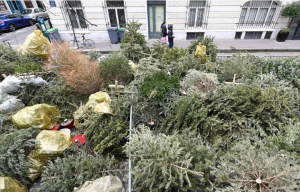Real or artificial tree? It’s a question faced by many people every December, who want to decorate their homes with the usual accoutrements of the holiday season, but do so in a sustainable, environmentally responsible way and minimise their impact on climate change. An artificial Christmas tree is said to prevent natural fir trees from being uprooted from where they belong. In fact, deforestation caused by Christmas festivities led to the creation of the first artificial trees in the late 19th century, made in Germany from green-dyed goose feathers attached to wire branches that were arranged around a wooden pole.
Although the natural Christmas trees on sale today usually come from tree farms, it is clear that felling a fir tree does have an environmental cost, as living trees sequester carbon dioxide (CO2) and release oxygen, storing the carbon in the growth of their plant matter. But the impact of artificial trees, now mostly manufactured in China from polyvinyl chloride (PVC), is also undeniable. Although this is a recyclable plastic, the traditional use of lead as a stabiliser makes this material a source of pollution, particularly as the PVC ages, and especially after nine years from the date of manufacture, according to one study. The PVC industry is replacing lead with other more environmentally friendly stabilisers, and in recent years China has encouraged the adoption of greener industrial processes.

The main advocate for artificial trees is the American Christmas Tree Association (ACTA), which represents artificial tree producers. A study commissioned by this organisation from WAP Sustainability Consulting in 2018 concluded that “on a one-to-one comparison, one real Christmas tree generates fewer environmental impacts than one artificial tree.” In the case of the plastic tree, the production and transport processes generate a greater impact. However, the report adds that these products are reused from year to year, and with more than 4.7 years of use, an artificial tree has a smaller environmental footprint than 4.7 real Christmas trees. Therefore, according to ACTA, “artificial trees have a more favourable effect on the environment if reused for at least five years.” Experts also note that it is important not to be fooled by appearances: in addition to the use of pesticides, the production of natural fir trees also consumes fossil fuels for transport and machinery. One estimate suggests that driving 16 kilometres each way to buy a real Christmas tree produces more emissions than the amount of carbon stored in the tree, while even the international sea transport of artificial trees is much more efficient.
However, the figures vary between studies, partly because the WAP and ACTA report did not take into account the large amount of carbon stored in the roots, which remain in the ground after a natural tree is cut down. Other research by the Canadian consulting firm Ellipsos concluded that the climate change and resource impacts of an artificial tree are three times that of a natural spruce tree for an average use of six years, and are only reversed if the plastic one is reused for more than two decades. The global consultancy Carbon Trust also significantly increased the estimated time needed for reuse: an artificial tree must be reused for at least 10 Christmases (between 7 and 20, depending on the case) to keep its environmental impact below that of a natural tree, it concluded, attributing two-thirds of the carbon footprint of the artificial tree to PVC and a quarter of that to emissions from its manufacture. The Carbon Trust estimates the carbon footprint of a two-metre artificial tree at 40 kilos of CO2.

But there is one common point on which experts agree, namely that the total environmental impact of the life cycle of both types of tree is mainly influenced by their final destination. If a natural tree is burned, all of its carbon content is returned to the atmosphere, so there is no gain. Much worse is if the fir tree ends up in a landfill, where its decomposition returns the carbon to the atmosphere in the form of methane, a greenhouse gas 28 times more potent than CO2. In this case, the estimated footprint of a two-metre-tall real tree is equivalent to 16 kilos of CO2, according to the Carbon Trust.
Experts therefore recommend that natural trees should be properly recycled by chipping or composting them to produce mulch, returning much of the carbon to the soil. Some researchers are also investigating ways to break down pine needles into useful compounds for industry, such as glucose, acetic acid and phenol. And, of course, the optimal solution, if possible, would be to use a natural, pot-grown tree and reuse it year after year, eventually replanting it in the ground.
Minimise the impact of our celebrations
The environmental footprint of Christmas is not limited to the tree. Consumption, large meals, festive lighting and travel all add to our environmental impact over the holiday season. To minimise the impact of our celebrations, the Carbon Trust has published a series of tips, most of which are self-evident: replace traditional lighting with LED lights, recycle, consume only what is necessary and don’t prepare kilos of food that ends up in the rubbish. But some of the tips are less obvious. For example, limit the use of glitter, a source of polluting microplastics; in October 2023, the European Union banned non-biodegradable plastic glitter, so only greener alternatives are now available.

When it comes to buying gifts, shopping online can avoid the carbon emissions associated with mass trips to the shopping centre, and help to concentrate consumption, although local shopping in neighbourhood shops will always be the preferable option. In any case, limiting packaging, especially plastic, is common advice. Giving virtual or digital gifts and experiences not only avoid a lot of packaging, but also an accumulation of items that in many cases end up in the landfill, with an estimated environmental cost of 80 kilos of CO2 per person.
On the other hand, in many parts of the world, Christmas is also synonymous with winter, the time of year when we need to heat our homes. Bundling up is always a greener alternative to wasting money on heating, especially with the lessons learned from the COVID-19 pandemic about the need to ventilate rooms where family gatherings take place. Finally, not all foods that can be prepared at this time of year have the same environmental cost: plant-based foods are the greenest, and turkey has a smaller footprint than red meat. All in the name of helping to ensure that we can continue to celebrate the holidays for many years to come.
Javier Yanes
Editor’s note: Original text of December 23, 2020 updated by the author
Comments on this publication